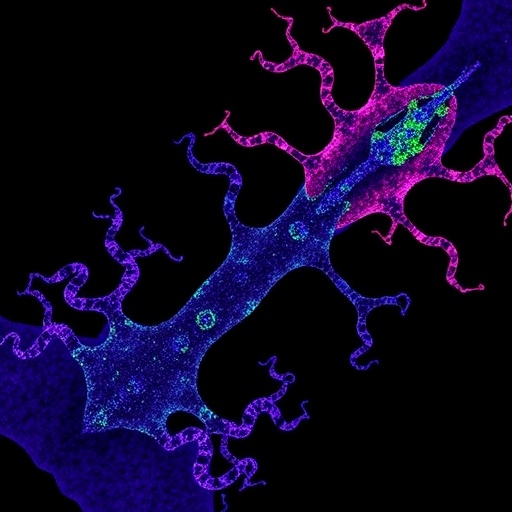
In a groundbreaking study published in BMC Cancer, researchers have unveiled the pivotal role of the Adenosine A2B receptor (ADORA2B) in the progression of head and neck squamous cell carcinoma (HNSC), while elucidating its influence on immune system interactions within the tumor microenvironment. This discovery hones in on ADORA2B as a critical oncogenic driver that not only facilitates tumor proliferation and migration but also orchestrates a highly immunosuppressive milieu, challenging existing therapeutic strategies and offering new avenues for targeted cancer therapy.
HNSC, a malignancy notorious for its aggressive behavior and poor clinical outcomes, has long eluded comprehensive understanding in terms of molecular drivers influencing tumor growth and immune evasion. The current study leverages state-of-the-art bioinformatics coupled with rigorous in vitro experimentation to dissect the multifaceted functions of ADORA2B. By integrating data from The Cancer Genome Atlas (TCGA) and Gene Expression Omnibus (GEO), the investigators provide compelling evidence that ADORA2B expression is markedly elevated in tumor tissues relative to adjacent normal tissues, indicating its potential as a tumor-specific biomarker.
Crucially, ADORA2B expression correlates strongly with advanced clinical staging and worse patient prognoses, as evidenced by diminished overall survival (OS) and progression-free survival (PFS) metrics. These findings suggest a prognostic utility for ADORA2B, whereby its detection could inform clinical decision-making and herald more aggressive disease courses. Functional pathway analyses reveal that high levels of ADORA2B coincide with the downregulation of key immune-related signaling cascades, underscoring a molecular basis for tumor-mediated immune suppression.
The data from immune infiltration assessments highlight an alarming pattern: tumors exhibiting elevated ADORA2B display lower immune and stromal scores, indicative of an inhospitable environment for immune cell infiltration. This immunosuppressive tumor microenvironment (TME) is particularly challenging in cancer therapy, as it dampens the effectiveness of immune-mediated interventions including immune checkpoint blockade (ICB) therapies. Indeed, patients with heightened ADORA2B activity demonstrated a poorer clinical response to ICB, signifying that ADORA2B may serve as an underlying mechanism driving resistance to immunotherapy.
By employing weighted gene co-expression network analysis (WGCNA), the study further delineates the biological networks entwined with ADORA2B expression. These analyses spotlight key gene clusters and signaling pathways that mediate both tumor proliferation and immune evasion, offering insights that could catalyze the development of combinational treatments targeting ADORA2B alongside conventional immunotherapies.
The translational significance of this research is amplified by in vitro experiments involving siRNA-mediated knockdown of ADORA2B in HNSC cell lines. These cell-based assays—comprising cell viability (CCK-8), colony formation, and wound healing experiments—conclusively demonstrate that silencing ADORA2B hampers cancer cell proliferation and curtails migratory capabilities. Such findings not only validate the oncogenic role of ADORA2B but also spotlight its viability as a therapeutic target.
Beyond the cellular and molecular underpinnings, computational drug sensitivity analyses identify promising therapeutic candidates capable of counteracting ADORA2B-driven tumor dynamics. Compounds such as Ixazomib citrate and Masitinib emerge as potential agents with efficacy against high ADORA2B-expressing tumors, revealing a pharmacopeia that could be repurposed or further optimized in clinical settings.
This study’s integrative approach, blending comprehensive genetic datasets with functional biological validations, exemplifies the future of precision oncology. Understanding the dual influence of ADORA2B in fostering tumor growth and sculpting immune escape mechanisms provides a foundational platform for the development of novel diagnostics, prognostics, and therapeutics specifically tailored to combat HNSC.
The immunological context of ADORA2B’s role uncovers a complex interplay: while adenosine receptors have been widely implicated in immune modulation, ADORA2B appears particularly adept at silencing immune activation within tumors, thus fostering a “cold” TME that resists immune attack. The suppression of immune cell infiltration not only facilitates tumor growth but also poses a formidable barrier to immunotherapies, which rely on robust immune engagement.
Clinically, the stratification of patients based on ADORA2B levels offers an avenue for personalized medicine, whereby those exhibiting high receptor expression might benefit from combined therapeutic regimens that simultaneously inhibit ADORA2B and reinvigorate the immune system. This precision approach could significantly enhance response rates and overcome resistance observed with monotherapies.
Equally important is the identification of ADORA2B as a biomarker predictive of immunotherapy outcomes. As immune checkpoint inhibitors continue to reshape the oncology landscape, markers that forecast therapeutic efficacy are invaluable. This study positions ADORA2B as a potential gatekeeper biomarker, signifying which patients are less likely to respond to current immunotherapies and may require alternative or adjunctive treatments.
From a mechanistic standpoint, ADORA2B’s role as a G protein-coupled receptor (GPCR) situates it within a highly druggable class of proteins, many of which have been successfully targeted in other diseases. This pharmacological tractability accelerates the timeline for drug development, encouraging the exploration of ADORA2B antagonists or modulators in HNSC.
Moreover, the study’s implications transcend HNSC, encouraging researchers to consider ADORA2B’s involvement in other solid tumors characterized by immune evasive behaviors. The receptor’s influence on the tumor microenvironment signals a broader relevance to cancer biology, positioning ADORA2B as a linchpin in the interface between tumor progression and immune regulation.
Taken together, these multifaceted insights paint ADORA2B not simply as a molecular hallmark of tumor aggression but as a central orchestrator of immune suppression and therapeutic resistance. Targeting this receptor could redefine treatment paradigms in head and neck cancers, offering hope for improved survival and quality of life for patients who currently face limited options.
The findings also underscore the necessity of continued interdisciplinary research bridging bioinformatics, immunology, and molecular oncology. As researchers further unravel the ADORA2B signaling axis, novel combination therapies, including ADORA2B inhibitors with immune checkpoint blockade or standard chemotherapeutics, may emerge as potent cancer interventions.
In conclusion, the elucidation of ADORA2B’s role in HNSC marks a significant leap forward in comprehending the molecular and immunological intricacies underpinning this formidable cancer type. By advancing our understanding of tumor proliferation, migration, immune evasion, and treatment resistance, this research charts a promising course toward more effective diagnostic and therapeutic strategies. As the oncology community embraces these insights, the targeting of ADORA2B could soon translate from bench to bedside, transforming patient prognosis and heralding a new era in cancer care.
Subject of Research:
Article Title: ADORA2B promotes proliferation and migration in head and neck squamous cell carcinoma and is associated with immune infiltration
Article References:
Li, P., Pang, Kl., Chen, Sj. et al. ADORA2B promotes proliferation and migration in head and neck squamous cell carcinoma and is associated with immune infiltration. BMC Cancer 25, 673 (2025). https://doi.org/10.1186/s12885-025-14102-2
Image Credits: Scienmag.com
DOI: https://doi.org/10.1186/s12885-025-14102-2
Tags: ADORA2B receptor in cancerbioinformatics in cancer researchclinical staging and prognosishead and neck squamous cell carcinomaimmune response in tumorsimmunosuppressive tumor milieuoncogenic drivers in HNSCCoverall survival in cancer patientsprogression-free survival metricstargeted cancer therapy strategiestumor microenvironment interactionstumor-specific biomarkers





